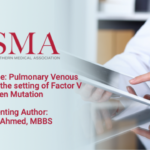Abstract | October 29, 2020
Double Trouble: Pulmonary Venous Thrombosis in the setting of Factor V Leiden Mutation
Learning Objectives
- This case describes the importance of being vigilant for rare conditions and identifying the underlying etiology. PVT is a rare condition without any exact data for prevalence.
- PVT usually occurs from a provoking condition as in this case, factor V Leiden mutation.
- PVT can have fatal outcomes if not diagnosed and treated appropriately in a timely fashion.
Introduction: Pulmonary vein thrombosis (PVT) is a rare and fatal condition if not recognized early that often presents with nonspecific symptoms such as cough, dyspnea, or hemoptysis. Etiological mechanisms include vascular torsion or direct injury (major trauma, post-surgical). Diagnosis is made with pulmonary angiography, ventilation-perfusion scans, MRI, and transesophageal echocardiography. Currently, there are no established guidelines for optimal management of PVT other than correction of underlying conditions.
Case Presentation: A 73-year-old Caucasian male with past medical history of COPD, emphysema, occupational exposure to chlorine and ammonia and history of multiple incidental pulmonary nodules (stable over 16 months) presented with complaints of progressively worsening shortness of breath and wheezing over 2 weeks. He did not use oxygen at home and was a lifetime non-smoker. He denied chest pain, leg swelling or pain. In the ED, vitals were significant for hypertension 162/92 and SpO2 89% on room air. VBG showed hypercapnia (pCO2 56.6). Physical exam was unremarkable except bilateral wheezing on auscultation. CBC, CMP and cardiac panel enzymes were within normal limits. Pulmonary CTA was negative for pulmonary artery thromboembolism but did show multiple stable pulmonary nodules and a thrombus in the pulmonary vein supplying the right lower lobe.
Working Diagnosis: Given concern for a hypercoagulable state homocysteine, protein C, protein S, and factor V Leiden mutation testing was performed. CT abdomen and pelvis was performed which was negative for malignancy. Patient was found to have heterozygous factor V Leiden mutation.
Management/Outcome: Patient was placed on IV heparin following pulmonary CTA results and vascular surgery consulted. There was no indication for acute surgical intervention. On day 3 of admission, the patient was transitioned to oral anticoagulation with apixaban. Patient was discharged home upon stabilization and return to baseline. Pulmonary CTA was repeated 3 months following discharge which showed resolution of PVT.

